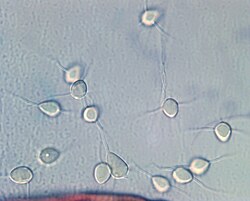Biology:Nia vibrissa
| Nia vibrissa | |
|---|---|

| |
| N. vibrissa | |
| Scientific classification | |
| Domain: | Eukaryota |
| Kingdom: | Fungi |
| Division: | Basidiomycota |
| Class: | Agaricomycetes |
| Order: | Agaricales |
| Family: | Niaceae |
| Genus: | Nia |
| Species: | N. vibrissa
|
| Binomial name | |
| Nia vibrissa R.T. Moore & Meyers
| |
Nia vibrissa is a species of fungus in the order Agaricales. The species is adapted to a marine environment and is a wood-rotting fungus, producing small, gasteroid basidiocarps (fruit bodies) on driftwood, submerged timber, mangrove wood, and similar substrates. The spores have long, hair-like projections and are widely dispersed in sea water, giving Nia vibrissa a cosmopolitan distribution.
Taxonomy
Nia vibrissa was originally described in 1959 from submerged wood off the coast of Florida. The Latin epithet "vibrissa" (meaning "bristly") refers to the hair-like appendages on the spores. It was initially thought to be a deuteromycete (an asexual or mould-like fungus),[1] but was subsequently found to be the sexual state of a basidiomycete, one of the few such known from the marine environment.[2] Since its fruit bodies are enclosed and its spores are passively released, Nia vibrissa was considered to be a gasteromycete and was placed in its own family within the Melanogastrales, a now obsolete order of terrestrial false truffles.[3]
DNA sequencing has since shown that the species is actually related to species of cyphelloid fungi and agarics within the Agaricales.[4]
Description
Fruit bodies are more or less spherical, yellow-orange to orange-brown, 1–4 mm across. The remarkable spores are oval, 10–15 by 6.5–8.5 μm with 4–5 bristle-like appendages up to 40 μm long.[1]
Habitat and distribution
The species is widely distributed in the Atlantic Ocean, the Mediterranean Sea,[5] the Indian Ocean, and the Pacific Ocean.[6]
Nia vibrissa has been shown to be a wood-rotting species[7] and was first obtained by leaving wooden "baits" in the sea, retrieving them after a period of time, and then examining them in the laboratory.[1] Other records of the fungus have come from a similar methodology, but it has also been found widely on dead mangrove wood[6] and on natural driftwood. Fruit bodies of the fungus were found on wood salvaged from the wreck of King Henry VIII's 16th-century warship, the Mary Rose.[8]
References
- ↑ 1.0 1.1 1.2 "Thalassiomycetes I. Principles of delimitation of the marine mycota with the description of a new aquatically adapted Deuteromycete genus". Mycologia 51 (6): 871–876. 1959. doi:10.2307/3755838.
- ↑ Doguet DG. (1967). "Nia vibrissa Moore et Meyers, remarquable Basidiomycète marin". Comptes Rendus de l'Académie des Sciences de Paris 256: 1780–1783.
- ↑ Jülich W. (1981). Higher taxa of basidiomycetes. Vaduz: Cramer Verlag. pp. 485.
- ↑ "Phylogenetic relationships of the marine gasteromycete Nia vibrissa". Mycologia 93 (4): 679–688. 2001. doi:10.2307/3761822.
- ↑ "Lignicolous marine fungi in the Straits of Messina, Italy". Hydrobiologia 206 (2): 149–154. 1990. doi:10.1007/BF00018641.
- ↑ 6.0 6.1 "A checklist of xylophilous basidiomycetes (Basidiomycota) in mangroves". Mycotaxon 107: 221–224. 2009. doi:10.5248/107.221.
- ↑ "Nia vibrissa — a marine white rot fungus". Transactions of the British Mycological Society 73: 35–40. 1979. doi:10.1016/S0007-1536(79)80069-8.
- ↑ "Observations on the marine gasteromycete Nia vibrissa". Mycological Research 97: 1–6. 1993. doi:10.1016/S0953-7562(09)81104-0.
Wikidata ☰ Q10600406 entry
 |

